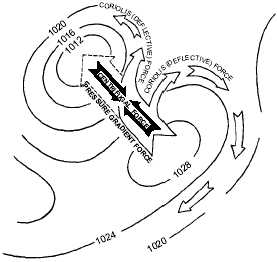directions throughout the fluid; e.g., if a pressure of
1013.2 millibars is exerted downward by the
atmosphere at the surface, this same pressure is also
exerted horizontally outward at the surface. Therefore,
a pressure gradient exists in the horizontal (along the
surface) as well as the vertical plane (with altitude) in
the atmosphere.
HORIZONTAL PRESSURE GRADIENT.—
The horizontal pressure gradient is steep or strong
when the isobars determining the pressure system (fig.
3-7) are close together. It is flat or weak when the
isobars are far apart.
VERTICAL
PRESSURE
GRADIENT.—If
isobars are considered as depicting atmospheric
topography, a high-pressure system represents a hill of
air, and a low-pressure system represents a depression
or valley of air. The vertical pressure gradient always
indicates a decrease in pressure with altitude, but the
rate of pressure decrease (gradient) varies directly with
changes in air density with altitude. Below 10,000 feet
altitude, pressure decreases approximately 1 inch of
mercury per 1,000 feet in the standard atmosphere. The
vertical cross section through a high and low (view A in
fig. 3-8) depicts the vertical pressure gradient. A
surface weather map view of the horizontal pressure
gradient in the same high and low is illustrated in view
B of the figure 3-8.
Pressure Gradient Force
The variation of heating (and consequently the
variations of pressure) from one locality to another is
the initial factor that produces movement of air or wind.
The most direct path from high to low pressure is the
path along which the pressure is changing most rapidly.
The rate of change is called the pressure gradient.
Pressure gradient force is the force that moves air from
an area of high pressure to an area of low pressure. The
velocity of the wind depends upon the pressure
gradient. If the pressure gradient is strong, the wind
speed is high. If the pressure gradient is weak, the wind
speed is light. (See fig. 3-7.)
Figure 3-9 shows that the flow of air is from the
area of high pressure to the area of low pressure, but it
does not flow straight across the isobars. Instead the
flow is circular around the pressure systems. Pressure
gradient force (PGF) causes the air to begin moving
from the high-pressure to the low-pressure system.
Coriolis (deflective) force and centrifugal force then
begin acting on the flow in varying degrees. In this
example, frictional force is not a factor.
Coriolis Effect
If pressure gradient force were the only force
affecting windflow, the wind would blow at right angles
across isobars (lines connecting points of equal
barometric pressure) from high to low pressure. The
wind actually blows parallel to isobars above any
frictional level. Therefore, other factors must be
affecting the windflow; one of these factors is the
rotation of Earth. A particle at rest on Earth’s surface is
in equilibrium. If the particle starts to move because of
a pressure gradient force, its relative motion is affected
by the rotation of Earth. If a mass of air from the
equator moves northward, it is deflected to the right, so
that a south wind tends to become a southwesterly
wind.
In the Northern Hemisphere, the result of the
Coriolis effect is that moving air is deflected to the right
of its path of motion. This deflection to the right is
directly proportional to the speed of the wind; the faster
the wind speed, the greater the deflection to the right,
and conversely, the slower the wind speed, the less the
deflection to the right. Finally, this apparent deflective
force is stronger at the Polar Regions than at the
equator.
Centrifugal Force
According to Newton’s first law of motion, a body
in motion continues in the same direction in a straight
3-9
1024
1028
1028
H
1020
GRADIENT WIND
FLOW
GEOSTROPHIC
WIND FLOW
AG5f0309
Figure 3-9.—Examples of circulation around high and low
pressure systems.


